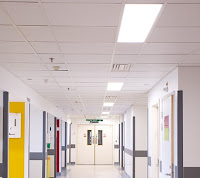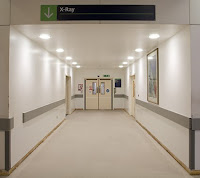TAG | hospital lighting
27
Thorn – Case Study – Chelsea & Westminster Hospital, UK
Comments off · Posted by admin in LED
For the UK National Health Service (NHS), a sustainable health and care system that works within the available environmental and social resources is the key to protecting and improving health now and for future generations.
This means working to reduce carbon emissions, minimising waste and pollution, making the best use of scarce resources, building resilience to a changing climate and nurturing community strengths and assets. Chelsea and Westminster Hospital NHS Foundation Trust is one of many NHS facilities with a series of new build and refurbishment projects.
Lighting targeted for significant energy reduction
The right partners, solutions and commitment to excellence
Setting the scene for the future
hospital led · hospital lighting · Novel Energy Lighting · thorn aquaforce · thorn cetus · thorn led lighting · thorn leopard · thorn omega
21
Video – How hospital lighting can help patients and save energy
Comments off · Posted by admin in LED
A panel of NHS facilities and energy managers and lighting professionals come together to discuss how lighting in hospitals can be tackled to improve patient outcomes and save energy
hospital led · hospital lighting · led lighting · led panels · led tubes · Novel Energy Lighting
21
How hospital lighting can help patients and save energy
Comments off · Posted by admin in LED
A panel of NHS facilities and energy managers and lighting professionals come together to discuss how lighting in hospitals can be tackled to improve patient outcomes and save energy

- What are the real benefits of investing in new lighting technology for healthcare?
- What are the key mistakes to avoid when upgrading lighting?
- What’s the latest knowledge on how lighting influences patient outcomes?
- How can we make healthier lighting a reality in healthcare facilities?
- How can healthcare bodies get funding for lighting upgrades?
There also needs to be better guidance on what works and what doesn’t and what is considered best practice. This would help me to convince people further up the chain and get funding”Damian Oatway
aurora led · energy efficient lighting · hospital led · hospital lighting · led lighting · Novel Energy Lighting
30
Why one London hospital is investing more than GBP1 million in lighting
Comments off · Posted by admin in LED
Alexandra Hammond is responsible for the environmental impact of Guy’s and St Thomas’ Hospital – and lighting is a significant part of that
Lux met Alexandra Hammond, associate director of sustainability from Essentia, at Guy’s and St Thomas’ NHS Foundation Trust, London. Here’s her view on lighting.
The hospital cares about its impact on the environment and society
I work for Essentia, which is part of Guy’s and St Thomas’ NHS Foundation Trust. I’ve worked for Guy’s and St Thomas’ for the past six years as head of sustainability. That role continues, and we are also able to offer our expertise to other public sector organisations. I look at everything to do with environmental and social impact for the hospital. And lighting is a big part of our energy strategy.
Upgrades are a challenge – but also an opportunity
I would say the biggest challenge we face is upgrading in areas that are quite sensitive, for example patient areas. Also making sure that we don’t get in the way. The exciting thing is that there are lots of opportunities, so if we can improve lighting in patient areas, that can only improve the healing process.
We are investing upwards of a million pounds in lighting at Guy’s and St Thomas'”
Our budget can accommodate change
We have a pretty comprehensive lighting upgrade programme across our two main acute care sites. We are investing upwards of £1 million ($1.5 million) in lighting at those hospitals. What we’ve done is to have an audit on their current lighting, and identified savings opportunities for a like-for-like change. But when we tender for the work – which we’ll be doing shortly – the idea is that we’ll be looking at everything, including biodynamic lighting.
We obviously have to see how we can work within the budget, but the wonderful thing about Guy’s and St Thomas’ is that it’s an organisation that thinks beyond direct paybacks.
Interestingly, the lighting project that we’re doing is part of a big energy-saving project that the trust is undertaking, so it’s about a £12 million ($17.8 million) overall investment in energy efficiency, and lighting comprises about a £1 million of that. What we’ve done is present the business case to the trust with a certain level of guaranteed savings. We’re doing an energy performance contract, so we have a partner that underwrites the savings. If it works within that budget and we get the savings back in, then they’re happy.
We want our patients to have control
I would love to do something creative in our patient areas, particularly on the care wards. We have a lot of patients that are in our wards for a significant amount of time, and lighting can be such an amazing healing factor. Conversely, the wrong lighting can be quite difficult for people, so it’s important that we get it right.
It gets exciting and interesting when you start to see how patients interact with light and how they can control it themselves and improve their stay while in hospital.
Lighting can be such an amazing healing factor for patients on our hospital wards”
LEDs are our default choice now
We do all our own internal maintenance, and we are very strapped for resources. We have an in-house engineering team and they’ve got lots to do. We’re a quite complex, variously aged estate, so the more that we can remove from them maintaining the basics, the better. If we can put in lighting that’s going to stand the test of time, that’s so helpful for us and gives us resources to do other projects.
The guidance we have is: ‘If not LED, justify why not.’ In some areas, we’ve upgraded to T5 so the payback is quite slow. But for the most part, we are moving to LED where we can.
We want our patients to be involved
My proudest moment will be giving our patients the control to make sure that, whether they’re in their own room or whether they’re in a ward, they have the ability to control lighting to give them the best experience possible. And that it actually works, because if the light switch is on and it’s right above the bed and it’s shining right in their eyes, that’s not going to do anyone any good.
The other thing is that we really ought to involve our patients in the process. We want to do some trials and get people to say: ‘I like this, I don’t like this.’ We’ve got the funding, which is the big thing, and we’re tendering for lighting in the next couple of months. My job is to make sure it doesn’t become a like-for-like switch-out, which it could. In some areas it will. That’s the sensible thing to do in some areas, but in others we need to be more creative.
One of the things I really am pleased about is that we’ve introduced photocell-controlled lighting almost across the board. We’ve eliminated the areas where we have lights on and bright sunshine at the same time.
I’d like to see more transparency and standards
One thing that would be really helpful with LEDs is more transparency in the way they’re manufactured and the quality. There’s still an element of having to go to the right supplier, the right manufacturer, the right… and that, I think, adds a premium to the likes of Philips.
But I also think that manufacturers could really help standardise. When we build a new ward, there’s a standard set-up for a hospital bed. It’s the number of plugs around the bed. It’s where the table goes, it’s where the lighting goes to a certain extent. It’s where the patient entertainment system is, and it’s a kind of standard thing, so we don’t recreate it every single time we do a new ward. It would be really good if there were a sort of standard set of principles that we could apply to patient areas. That would help us reduce the design costs, and to just get things done.
Novel Energy Lighting has supplied LED lighting for several NHS trust lighting upgrades. We have the expertise to work with hospital specifiers, survey buildings, and deliver quality LED goods with 5 year warranties. Call us today to discuss: Tel: 0208-540-8287
hospital lighting · LED lamps · led lighting · led tubes · lux magazine · nhs led · nhs lighting · Novel Energy Lighting





